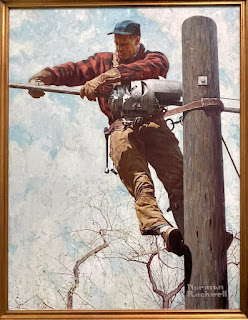After viewing the MAD Magazine exhibit, we walked into the main gallery to see the work of American illustrator, Norman Rockwell. The museum was very, very crowded so it was sometime hard to see and to photograph the paintings.
I've only seen Rockwell's work in magazines so it was astonishing to see how big some of these paintings are. Many of them were almost life size like The Four Freedoms (1943)
Freedom from Fear
Freedom of Speech
Rockwell staged his paintings to tell a story using local people and props. He would take photographs of the setting so he could finish the painting. Preserved in a glass case was the worn, leather jacket that the town meeting member wore.
Freedom to Worship
Freedom from Want
The Runaway (1958)
It was also a surprise to see studies of some of the paintings. We forget that a lot of work goes on behind the scenes before artwork is produced. Even for the big name.
"Norman Rockwell's boyhood experience growing up just north of New York City provided inspiration for this popular painting. I ran away from home when I was a kid in Mamaronek, and mooned around the shore, kicking stones and watching the whitecaps on Long Island Sound. Pretty soon it began to get dark , and a cold wind sprang up and moaned around the trees. So I went home. Many years later, Rockwell brought eight-year old Ed Locke and Massachusetts State Trooper Dick Clemens to a Howard Johnson's in Pittsfield, Massachusetts where they were photographed as models for The Runaway. After completing a first canvas capturing the restaurant's modern decor, Rockwell rejected it and produced a second version with a sparer setting. (Often thought to be Joe's Diner in Lee, Massachusetts) Asked by Clemens why he made the change, the artist explained that a rural background would give the impression that the little boy had gotten further out of town."
No Swimming (1921)
Most of us think of or remember Rockwell's work on the cover of The Saturday Evening Post. He left that publication to do covers for Look magazine where he had more freedom to express his political views of the time. Such as the painting above New Kids in the Neighborhood (1967)
The Problem We Live With (1963)
"for Look Magazine was based upon an actual event, when six-year old, Ruby Bridges, was escorted by U.S. Marshalls on her first day at an all white New Orleans school. Rockwell's depiction of the vulnerable but dignified girl clearly condemns the actions of those who protest her presence and object to desegregation. The piece commemorated the 10th anniversary of the Brown v. Board of Education Supreme Court Ruling that separate is not equal in America's public schools"
Golden Rule (1961)
The Lineman (1948)
Murder in Mississippi (April 6 - 13, 1965)
"In the beginning of 1965, Rockwell began work on a piece about the June 21, 1964 murders of three, young civil rights workers. Michael Schwerner, and his chief aide, James Chaney, were in Philadelphia, Mississippi to help train volunteers like Andrew Goodman, who along with other college students were working to expand voter registration as part of the Mississippi Summer Project. The anatomy of Murder in Mississippi illuminates Rockwell's intensive focus on the incident and process of making a painting that expressed his outrage. Veering from his habit of working on five or six projects at a time, he ignored other commissions, and in an intensive five-week session gathered research and produced charcoal preliminaries, and oil color study, and a large final painting. In an interview later in life, Rockwell recalled having been directed by the Post to remove an African-American from a group picture because the magazine's policy dictated showing black people in service industry jobs only. Freed from such restraints at Look, he sought to correct the editorial prejudices that had been reflected in his previous work. On April 14, Rockwell sent his final painting to Look. On the 29th he received word that Look had decided to use his color study rather than the final painting. In a letter to Look editor art director Allen Hurlburt, Rockwell wrote, I tried in a big way...to make an angry picture. If I just had a big of Ben Shahn in me it would have helped."
Girl at Mirror (1954)
2OLOTR (Two Old Ladies on the Road)
.JPEG)
















The paintings are incredibly detailed. What a gift he had.
ReplyDeleteHe did at that.
DeleteEvery time you post one of these adventures I interpret the title as twenty lord of the rings . Airways takes me a (senior) moment to get it right 🙃
ReplyDelete🤣
DeleteWhat a fascinating man. I had no idea. Thanks for sharing, CJ. Sandra sandracox.blogspot.com
ReplyDelete😊
DeleteI do like the paintings you've shown.
ReplyDeleteWishing you a happy end of week.
All the best Jan
😊
DeleteWhen I visited I really enjoyed seeing the original Norman R. paintings. But my favorite one is of both of you old ladies on road. :) Hope you stayed warm today.
ReplyDeleteThis latest photo of us is one of my favorites.
DeleteThank you for this look round the exhibition.I love Norman Rockwell's art and a visit to his studio and exhibition was the highlight of my trip to America many years ago. I was amazed at the scale and beauty of 'the problem we live with.'
ReplyDeleteThe scale of his works surprised me.
Delete